So you want to go winter hiking or snowshoeing, but… What do you wear? How do you stay warm? And how can you transition your summer hiking wardrobe into the winter season?
I definitely had all of these questions when I first started winter hiking and snowshoeing, and through years of trial and error (oh so many errors!), I’ve come up with a bunch of pretty good winter hiking outfits that work for a variety of cold temperatures.
So here it is – my guide for what to wear winter hiking and snowshoeing. In includes:
- How to dress in layers: What is each layer called and what is it for?
- Base layers for winter hiking: recommendations for long underwear tops and bottoms
- Mid layers: When do you want a fleece jackets vs. an insulated down or synthetic puffy?
- Outer layer jackets: What to look for in a waterproof breathable jacket
- Outer layer pants: What kind of pants should you wear for winter hiking? (Ski pants, rain pants, soft shell pants, or winter tights?)
- Boots for winter hiking: Insulation and waterproofness are key!
- Socks: Warm, cozy, and blister-preventing
- Gaiters: Keep the snow out of your boots
- Snowshoes and microspikes: Add traction and flotation in snow and ice
- Accessories to keep you warm: hats, gloves, and neck gaiters (buffs)
- Winter hiking checklist: use this list of winter hiking clothing to plan your next trip
Hey there: Some of the links in this post are affiliate links, which means I earn a small commission at no cost to you. Thanks for your support. -Taryn
How Cold Will it Be?
The first thing to do is figure out how cold it will be. Don’t just look at the weather forecast for your city – the temperatures can be MUCH colder in the mountains. Use my picks for The Best Weather Apps for Hiking to get a better idea of the forecast on the trails.
In my hometown of Squamish, BC, our winters are typically not that cold: temperatures between +5°C and -10°C (41°F and 14°F) in the mountains are pretty typical.
In that climate, as long as you are moving and not taking long breaks, you won’t need any Everest expedition-level super warm clothing.
If you are heading out in colder temperatures, you will obviously need warmer clothing.
Dress in Layers
The secret to staying comfortable while winter hiking or snowshoeing is layering. You take off layers when you get too hot and add more when it cools down.
It’s also important to wear the RIGHT amount of layers. If you wear too many, you’ll overheat and sweat. Then when you stop, all that cold perspiration in your clothing will cool you down too quickly, or even worse, turn to ice.
My winter hiking and snowshoeing mantra is “Be bold, start cold”. I always wear less layers to start with since I know I’ll warm up as I move. I carry warm gear in my pack to put on when I stop.
The classic layering system consists of a base layer, mid layer and outer layers. Here’s what each layer does:
- Base layer: Wicks sweat and provides warmth.
- Mid-layer: Provides customizable warmth that you can add or subtract depending on the temperature and how hard you are working.
- Outer-layer: Provides protection from wind and rain.
I’ve got details on each of those layers below.
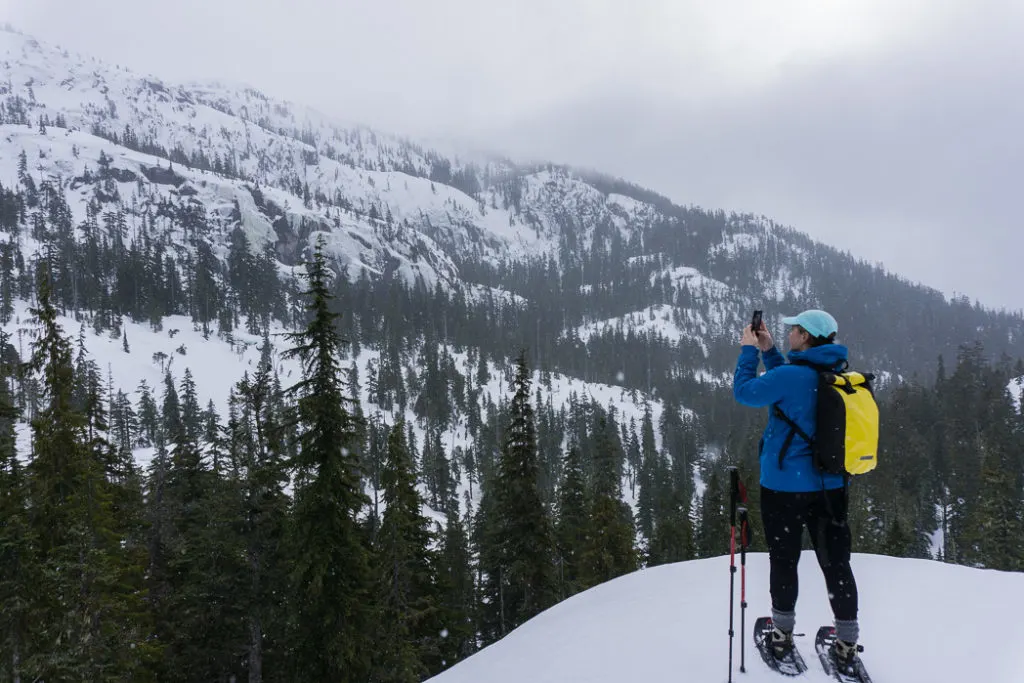
Base Layers to Wear Winter Hiking and Snowshoeing
A good winter hiking outfit starts with a warm and wicking base layer (also known as long underwear). If you are starting from scratch, choose mid-weight base layer pants and a long sleeved mid-weight base layer top.
Polyester and merino wool are both great options for fabric that retains warmth even if you get wet. I mostly wear polyester since it’s cheaper and more durable, but merino wool can be great if you can afford it. (Read my guide to whether Merino wool is worth it for more info.)
If you get cold easily, live in a very cold climate, or plan to go winter camping, consider getting heavy-weight base layers instead of mid-weight.
For synthetic base layers, I like Patagonia’s Capilene Midweight collection. It has a subtle grid-texture on the inside that traps warmth without adding bulk.
If you’re looking for merino wool base layers, I love the Smartwool Classic Thermal series. It provides the right amount of warmth for snowshoeing. Their base layer bottoms have a wide waistband that stays put. (And they come in fun patterns too).
Underwear
You’ll also need to wear quick-drying underwear underneath your base layer. (Skip the cotton – it will just get soggy with sweat!) Read my guide to hiking underwear to find out which ones are best.
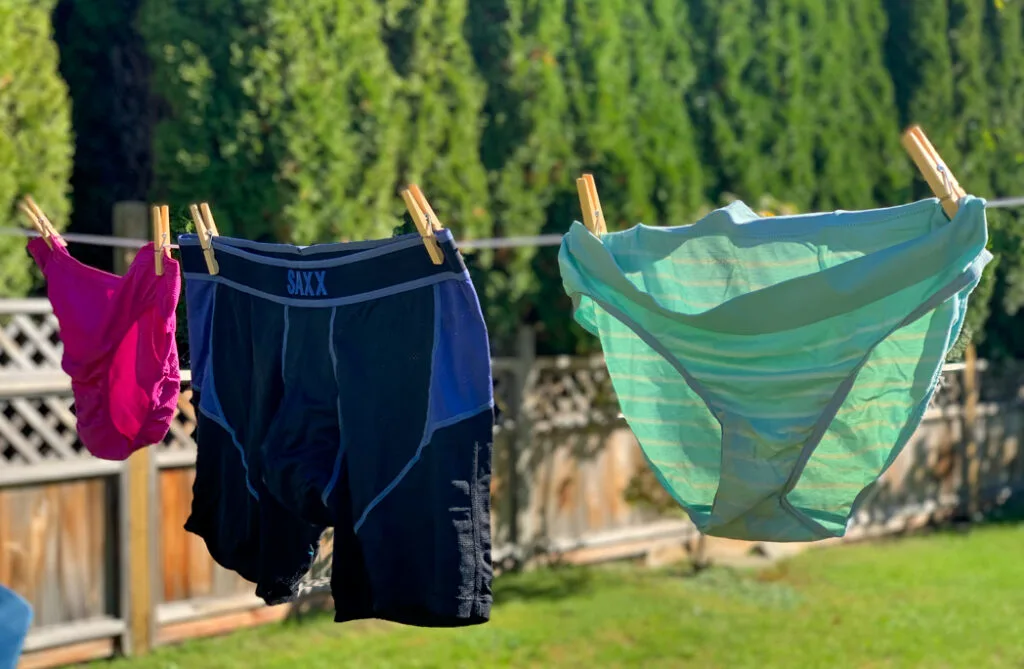
Mid Layers to Wear Snowshoeing and Winter Hiking
The next layer is the mid-layer. The main job of the mid-layer is to provide extra warmth. This is the most customizable layer – choose a warmer mid-layer for cold conditions and a lighter one for milder weather.
Your mid-layer is also the layer that you will take on and off the most as the temperature changes or your exertion level increases or decreases.
Mid-Layer Jackets: Fleece vs. Synthetic Insulated vs. Down
A lightweight insulated puffy jacket or a mid-weight high-loft fleece jacket is a good option to wear winter hiking and snowshoeing for extra warmth. Or just keep it in your bag to throw on while taking breaks.
There are two types of jackets to consider: fleeces and insulated jackets.
Fleece jackets provide a moderate amount of warmth and wick sweat, so they are great to wear when you are moving fast or in mild weather.
In colder weather you will want an insulated puffy jacket for extra warmth. I prefer to snowshoe and winter hike in a fleece jacket, then carry a lightweight down jacket to put on when I take breaks or if it’s extra cold.
For insulated puffy jackets you have a choice between down and synthetic insulation. Many people like the warmth and compressibility of a down jacket. A synthetic jacket can be a better choice in damp conditions such as humid coastal climates, temperatures close to freezing, or during sweaty activities.
Synthetic jackets dry faster than down and keep you warm even when wet. But they aren’t as light or compressible. Down jackets don’t provide any warmth once they are wet and take a long time to dry.
Fleece Jackets
I have a few fleece jackets but I love, but most of them are discontinued. In general, I look for fleeces that have a bit of stretch. I also like grid fleece since it breathes well but still provide lots of warmth.
One of my faves that is still available is the MEC Rockwall Fleece. It has a smooth water resistant outer face but is fleecy and soft on the inside. It’s also pretty stretchy.
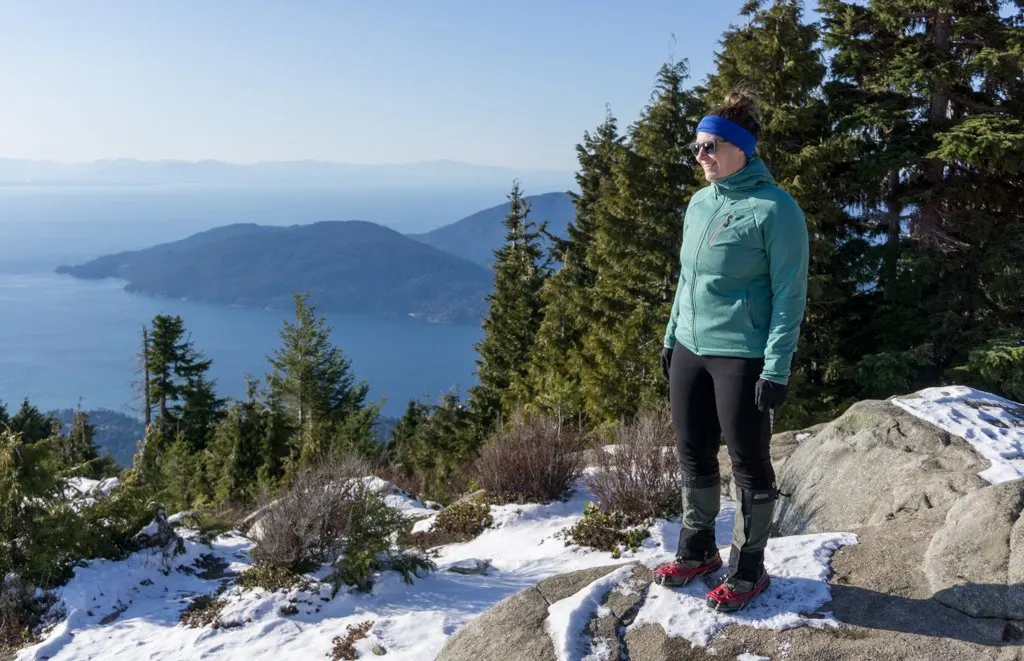
Insulated Puffy Jackets
I have a ton of puffy jackets, so I find it hard to choose which one to bring on some trips. For a synthetic puffy, I reach for my Arc’teryx Proton most often. It’s really breathable, and the synthetic insulation keeps me warm even when its wet.
Sometimes I also pack my Arc’teryx Cerium down jacket if it is going to be really cold. It’s super warm and squishes down really small so it is great to have in my pack. Since it is down, I save it to wear when I’m taking a break since (like all down jackets) it doesn’t deal with sweat well.
Mid-Layer Bottoms: Fleece Pants
For midlayer bottoms some people like to wear lightweight fleece pants. I find fleece pants are too warm to wear when snowshoeing, especially if I’m wearing long johns or tights.
Unless you are really a cold person or out in very cold temperatures, I’d go with either a baselayer or a midlayer on the bottom but not both. I have an older pair of MEC Trek pants that I wear for winter camping.
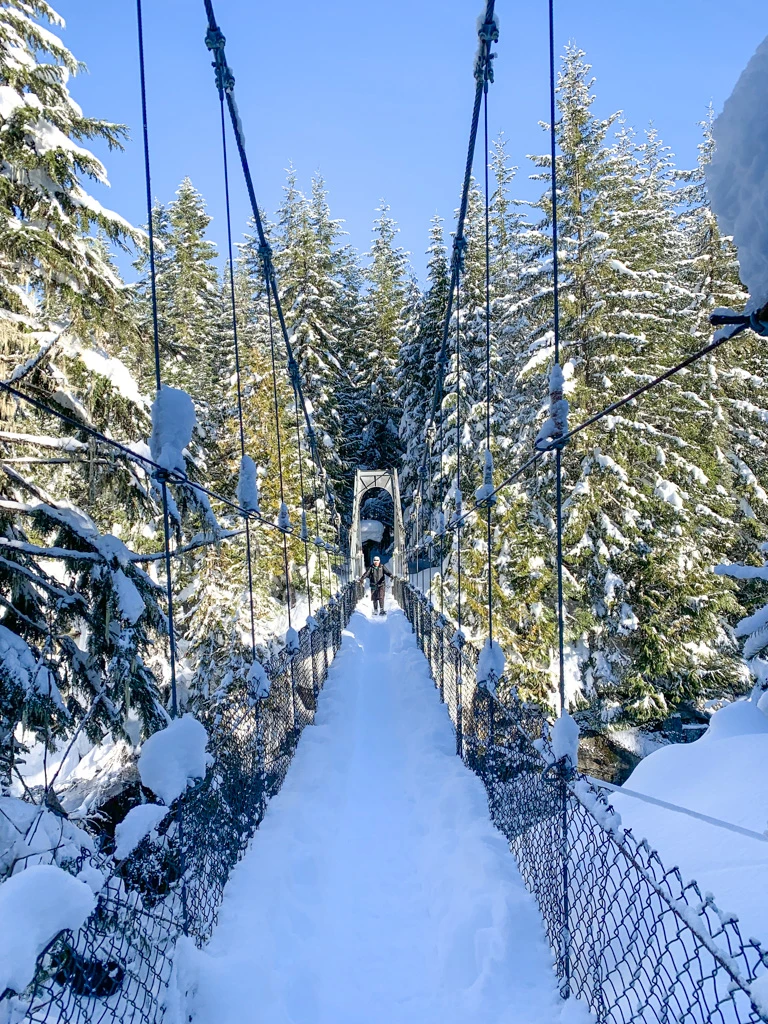
Outer Layers Jackets for Snowshoeing and Winter Hiking
Even in nice weather, it’s important to have an outer layer for snowshoeing and winter hiking. Your outer layer protects you from wind, rain, and snow. I often winter hike in just my base layer under my outer layer (no mid-layer).
For hiking in any season, you need a rain jacket since it can rain or snow at any time of year in the mountains.
Make sure you choose a jacket that is both waterproof and breathable so you don’t sweat inside it. That usually means a jacket with Gore-Tex or another waterproof breathable technology. (Check out my guide to why rain jackets wet out to learn more about waterproofing.)
There are lots of technologies out there and many brands use their own, but as long as the jacket is advertised as a waterproof breathable garment, you can be sure it is waterproof.
If you spend more money for Gore-Tex or another branded technology you’ll often get more durability and a lot more breathability, but the waterproofness straight off the shelf will be comparable to the cheap jackets.
I like high quality waterproof breathable jackets to wear winter hiking and snowshoeing since the consequences of getting wet are so much higher when it’s cold out.
I just upgraded to the Outdoor Research Aspire Jacket. (The men’s version is called the Foray.) It’s a durable 3-layer waterproof breathable jacket with a bit of stretch so it’s comfortable to wear. I also love the huge pit zips which are great for venting heat when I’m working hard or giving me access to the pockets in my mid layer.
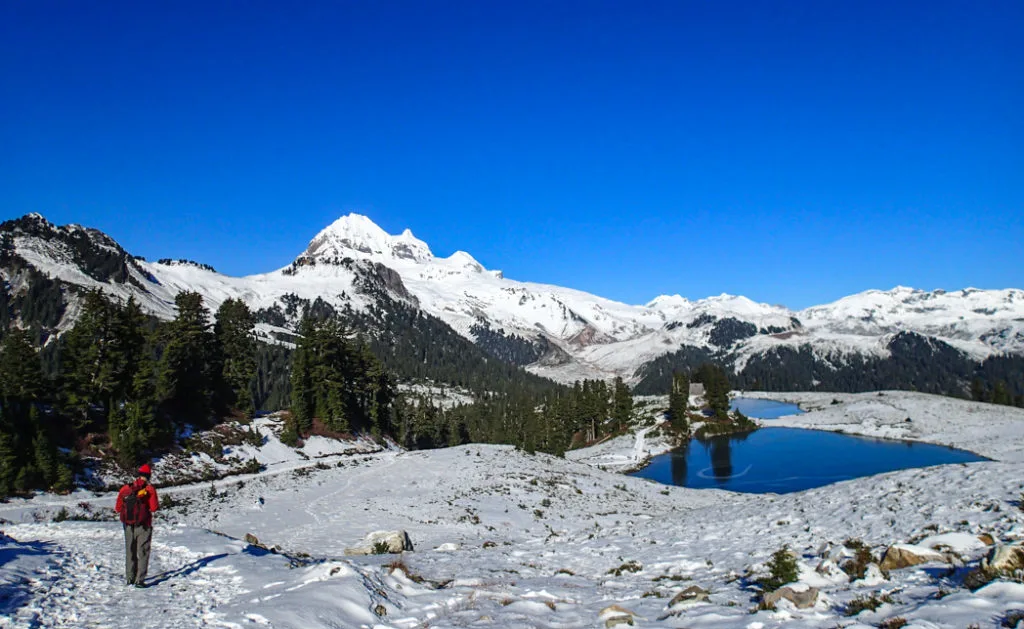
Outer Layer Pants for Winter Hiking and Snowshoeing
You have a few choices when it comes to picking a type of outer pants for snowshoeing or winter hiking. The type you choose will depend on your budget, how cold it is where you hike and what style of hiking you do.
Below I’ve got info on winter tights, soft shell pants, rain pants, insulated ski pants, and insulated skirts.
Winter Tights/Leggings
In mild-weather or when I plan to do a short hike where I’ll be working hard, I often wear winter tights for snowshoeing.
I have a pair of Athleta Altitude Leggings that I love so much I bought a second pair. They are made of stretchy and warm Polartec fleece. (These aren’t the crappy yoga tights with a fuzzy lining that you see on Amazon.) I wear them on their own without a base layer when it’s cold but not windy.
If it’s windy, I like leggings with a fleece lining and wind resistant outer fabric. I keep a pair of rain pants or an insulated skirt in my backpack to put on overtop in case it gets cold. (More on those below.)
I have an older pair of discontinued winter biking tights that I wear for snowshoeing and winter hiking. They have a cozy fleece lining and windproof panels on the front only, since they’re designed for biking.
Tights designed for cross-country skiing will also be great for snowshoeing since they have windproof panels. Craft, Swix, and Salomon all make great options.
READ NEXT: 18 Best Hiking Leggings
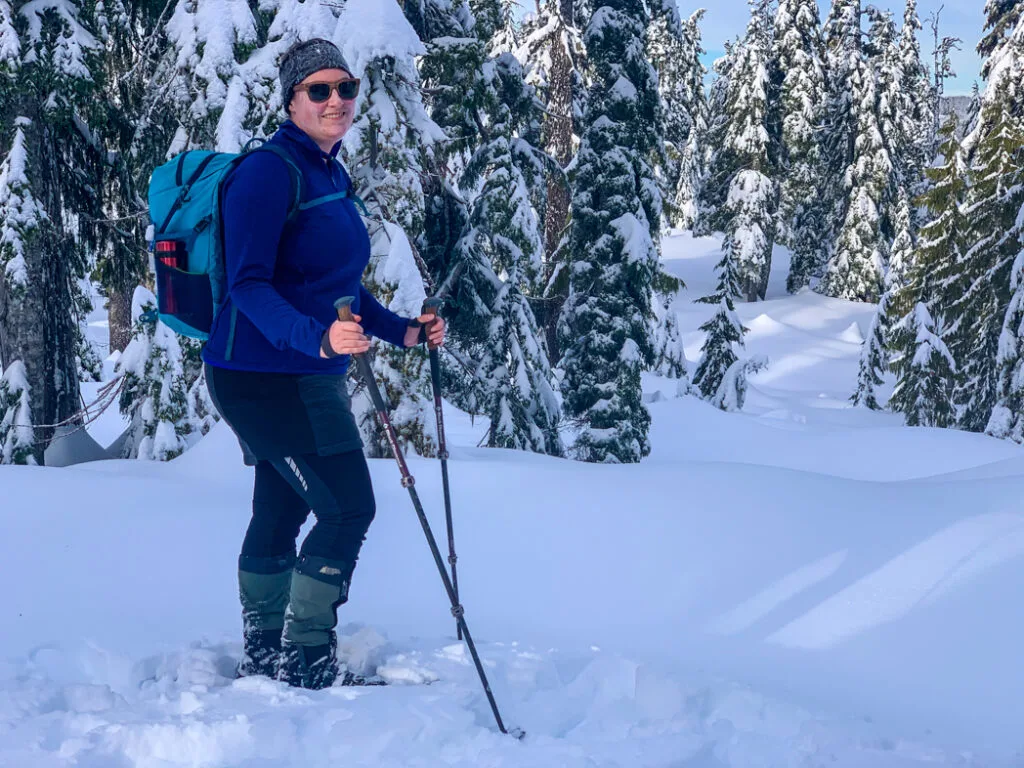
Soft Shell Pants
For most trips, I like to wear softshell pants for winter hiking and snowshoeing since they are wind resistant and water resistant.
Key point: they aren’t waterproof so they won’t hold up to constant rain, siting in the snow, or bum sliding.
They are also quite breathable so they are good for days when you are working hard or it’s not that cold.
There are a few softshell pants on the market designed for snowshoeing or winter hiking, but I’ve found that pants designed for ski touring also work really well for snowshoers. Many softshell pants designed for winter have a thin fleecy layer inside for extra warmth so on warmer days you can skip a baselayer.
I have an old pair version of the MEC Tobo soft shell pants. They breathe well but still block the wind. They also shed snow but won’t stand up to heavy rain.
Ski touring pants like the Outdoor Research Cirque pants are similar. They are built for ski touring and have a fleece lining.
Rain Pants
Many people (including me) like to wear waterproof breathable rain pants over their base layer for winter hiking and snowshoeing. They are windproof so they’ll retain body heat. This means you might get overheated in them, so get ones with zippered leg vents if you run hot.
They also tend to be light weight and packable so you can take them off on bluebird days and just go in your tights or long johns. And since they are totally waterproof they are the best option for days where it is sleeting, for sitting in the snow, or for bum-sliding.
The bonus is that you can use them as rain pants at other times of the year so you don’t have to buy a dedicated pair of winter pants.
I have the MEC Hydrofoil Stretch Pants. I love them since they have 3/4 length zips for easy on/off. I’ve worn them on countless summer backpacking trips and winter hikes. I also love that the fabric stretches a little so they are more comfortable.

Insulated Ski Pants
Another option for winter hiking and snowshoeing is to wear ski or snowboard pants. Many people already have these in their closets. If you don’t, they are easy to find at used gear shops or on clearance at ski stores.
Most of them have good waterproofness, although they often aren’t as waterproof as rain pants. Most ski pants are insulated which can be too warm for hiking in, especially in warmer weather. It’s waaay too easy to overheat and start to sweat.
If you want to snowshoe or winter hike in ski pants, I recommend you buy a cheap pair. You don’t need to worry about durability the way you would with ski pants since you won’t be falling down on them. (Or I hope you won’t anyway!)
There are tons of budget options on Amazon, but insulated ski pants from Arctix get the best ratings.
If you want insulated pants from a more reputable brand, Columbia’s Bugaboo Omni-Heat Snow pants are value-price, but great quality.
Insulated Skirts
When I first heard about insulated skirts I thought they were silly and for people who cared about fashion. But I’ve since come around to the conclusion that they are so functional!
Often when you’re exercising in cold weather your butt and thighs get cold but the rest of your legs are warm. That’s where insulated skirts come in.
I got an insulated skirt a few years ago and have worn it a LOT the past three winters. I like to layer it over winter tights. If I get really warm, I take it off and stow it in my pack, then put it back on when I take a break or cool down. Some have a full side zip so they are easy to take on and off.
I have a Smartwool Smartloft Skirt. It has stretchy and warm side panels with insulation on the front and back. Since it’s from Smartwool, the waistband and inside lining are cozy merino wool.
READ NEXT: Best Insulated Skirts to Keep Your Butt Warm on the Trails
Boots for Winter Hiking and Snowshoeing
If you already own waterproof hiking boots, they will work great for winter hiking and snowshoeing. Just make sure they are really waterproof. If they’re not, the heat from your feet will melt any snow on the outside, which will leak inside and cause cold feet. Brrr!
If you snowshoe regularly, I recommend investing in a pair of insulated winter hiking boots. Read my guide to the best boots for snowshoeing to learn what features to look for in snowshoeing boots.
(Tip: Winter hiking can cause blisters since the slippery snow moves your foot around inside your boots. Get my tips for preventing blisters.)
I wear Salomon Vaya Powder insulated hiking boots for snowshoeing. They are warm, have ankle support, and are totally waterproof. Unfortunately, they are discontinued.
I recommend you check out the Salomon X Ultra Snowpilot Waterproof Winter Boots. I’ve been wearing the summer version of these boots for years and love them.
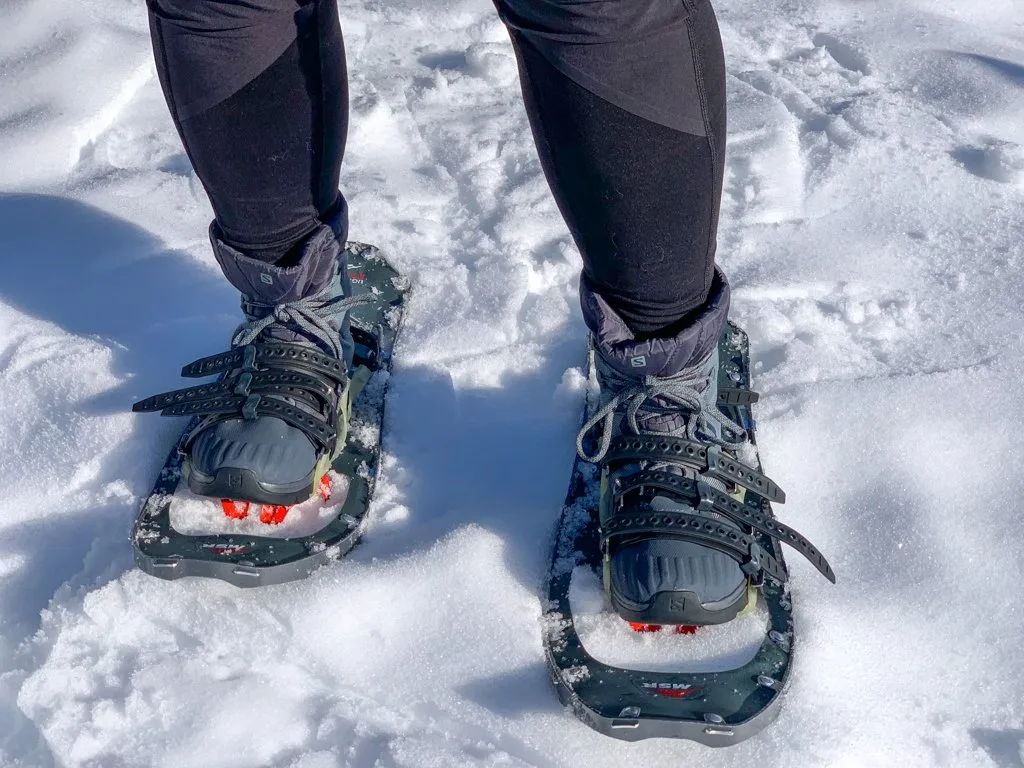
Socks for Winter Hiking and Snowshoeing
Comfortable hiking socks are one of the keys to happy winter hiking and snowshoeing. I wear thicker wool socks in the winter time to add warmth. Make sure your socks fit well and aren’t too thick for your shoes. Read my tips for preventing blisters.
My favourite socks for winter hiking are the Darn Tough Midweight Hiker Socks since they last forever.
If you get really cold feet, an easy way to add warmth when you snowshoe is heated socks. I haven’t tried them yet, but a friend with Reynaud’s disease (a circulatory disorder that causes cold hands and feet) swears by heated socks. The have a small battery pack and you can control the temperature with an app on your phone.
These heated socks from Amazon get good reviews are are pretty reasonably price. are a few different heated sock companies out there, but I’ve heard good things about Hotronic heated socks.
Gaiters for Winter Hiking and Snowshoeing
Even if you have waterproof boots, you can’t really go out in the snow without a pair of gaiters. These bridge the gap between the top of your boots and the bottom of your pants and make sure you don’t get snowy socks. Even really basic and cheap water resistant ones will be fine, but you can’t skip these.
I’ve had a pair of MEC Kokanee Gore Tex gaiters for years. They have been on countless snowshoe trips and I also love them for coastal hiking.
Any waterproof or water resistant gaiters will work for winter hiking and snowshoeing (the Gore Tex is for breathability for summer use in sand and mud).
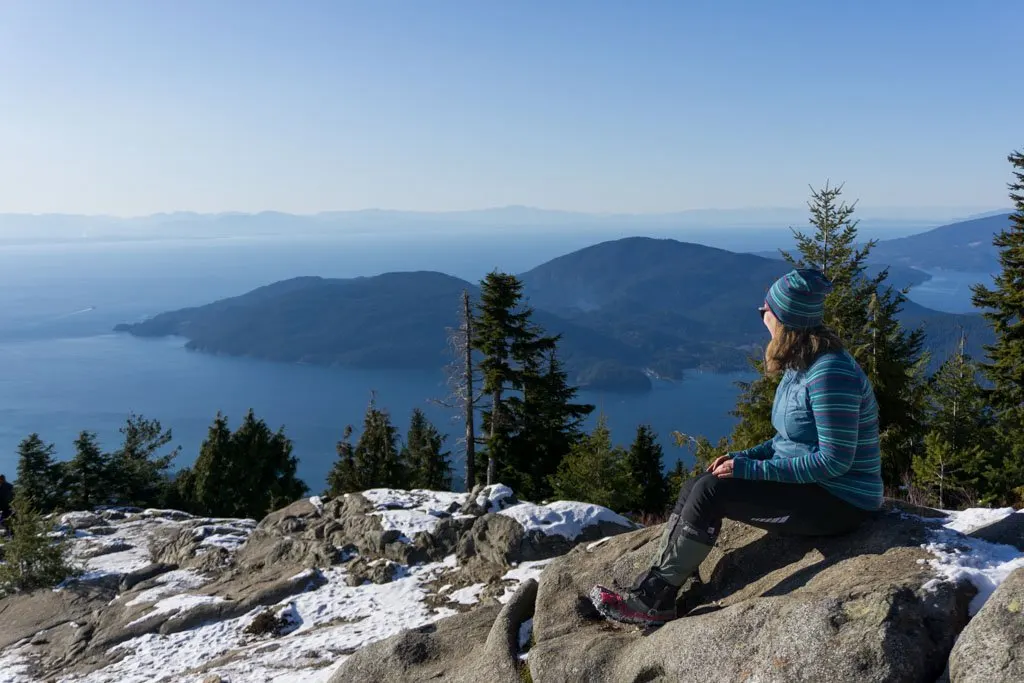
Snowshoes and Microspikes for Winter Hiking
For deep snow, of course you will need snowshoes. (I’ve got a whole guide on how to choose snowshoes if you need help!)
I love my MSR Lighting Ascent snowshoes since they are lightweight but grip well on steep slopes.
When the snow is not very deep or the trails are icy you still need something to keep you from slipping. (Slip and fall cause the most common snowshoe and winter hiking injuries. Read my post about snowshoeing safety to learn how to prevent them.)
That’s where crampons or microspikes come in. They come along in my pack for every winter hike since I never know when I might need them. (Read my guide to crampons vs. microspikes vs. snowshoes to understand the difference between these traction devices and when to use them.)
For microspikes, I can’t say enough good things about my Kahtoola Microspikes. They are easy to put on but provide lots of grip.
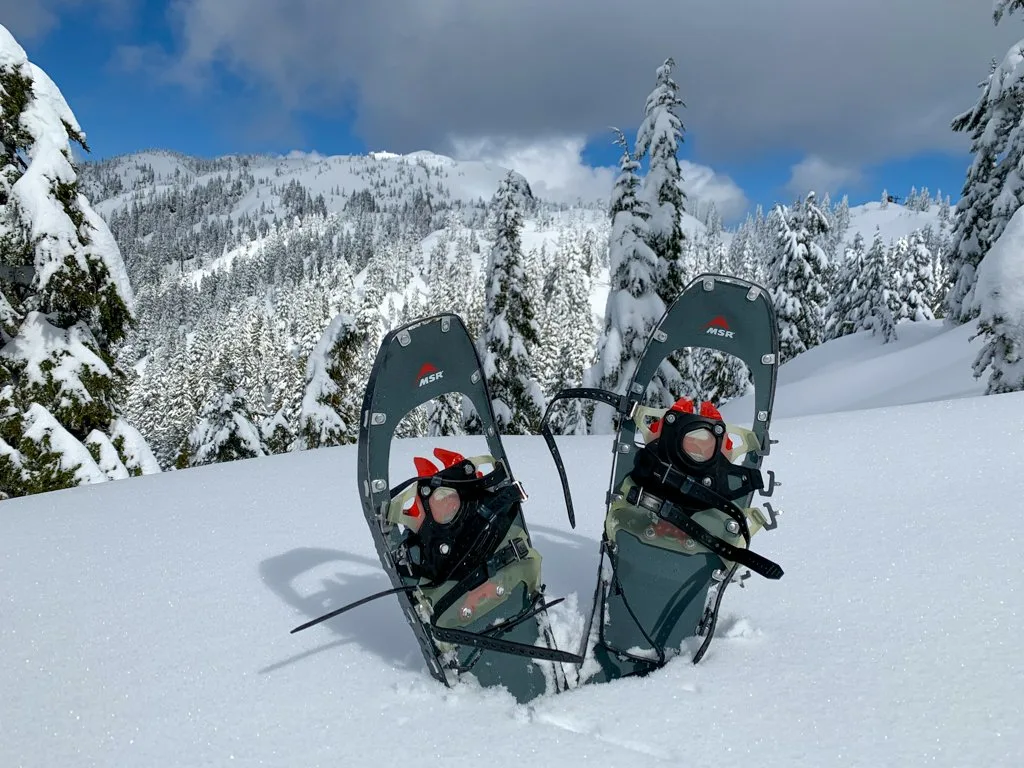
Accessories to Wear Winter Hiking and Snowshoeing
When you’re out freezing weather, your hands and head often feel cold first, so make sure you wear a warm hat and some gloves.
Actually you’ll probably want two pairs of gloves: one pair of lightweight fleece gloves and one pair of insulated and waterproof or water resistant ski gloves or mitts. It’s good to have both since your hands will be warmer while you are moving, but cold when you stop or when you are exposed to the wind.
Pretty much any basic fleece gloves will be great for winter hiking or snowshoeing. I like ones with touchscreen pads so I can still use my phone.
Make sure you bring waterproof insulated ski gloves too. I actually prefer mittens since they keep your fingers warmer.
Another accessory that I like to bring is a wool or fleece buff/neck gaiter. You can wear it as a headband, as a hat, around your neck or over your nose and mouth – I always bring one and always find a use for it. I always bring a merino wool buff (in fact I have three of them!)
Winter Hiking Checklist
Make sure you have everything you need before you head out on your next winter hike or snowshoeing trip. Here’s a winter hiking checklist that includes everything you need to wear for winter hiking and snowshoeing:
- Mid-weight or heavy-weight synthetic or merino wool base layer top
- Mid-weight or heavy-weight synthetic or merino wool base layer bottoms
- Quick-drying synthetic or merino wool underwear and sports bra
- Warm merino wool or synthetic hiking socks
- Mid-layer jacket: insulated down or synthetic jacket and/or fleece jacket
- Mid-layer fleece pants (optional – likely only for very cold weather)
- Waterproof breathable rain jacket
- Outer layer bottoms: rain pants, winter tights, soft shell pants, ski pants, or insulated skirt
- Warm wool or fleece beanie hat/toque
- Wool neck gaiter (buff)
- Fleece gloves
- Insulated ski gloves or mittens
- Waterproof hiking boots or insulated hiking boots
- Snowshoes
- Microspikes
- Waterproof or water-resistant gaiters
So that’s my run-down on what to wear winter hiking and snowshoeing. I know that this layering system will keep you warm and dry on your next winter hike. Just remember not to let yourself overheat and get sweaty! Do you have tips for winter hiking clothing? Leave them in the comments.
More Snowshoeing and Winter Hiking Posts:
- 9 Tips for Winter Hiking (You Don’t Have to Freeze!)
- Snowshoeing Safety: 14 Ways to Get into Trouble and How to Prevent Them
- How to Choose Snowshoes: A Complete Guide
- The Best Boots For Snowshoeing
- Best Gifts for Snowshoers (25+ Ideas)
- Microspikes vs. Crampons vs. Snowshoes: What’s the Difference?
More Hiking Gear Posts:
- 17 Ways to Save Money on Hiking Gear
- Best Insulated Skirts to Keep Your Butt Warm on the Trails
- Why Do Rain Jackets Wet Out?
- The 10 Essentials: Things You Should Bring on Every Hike
- Best Insulated Skirts For Hiking and Snowshoeing in 2026 - December 5, 2025
- Snow-Free Hikes in Vancouver: 50+ Year-round Trails - December 4, 2025
- 2025 Altitude Sports Black Friday Sale: My Picks for the Best Deals - November 25, 2025

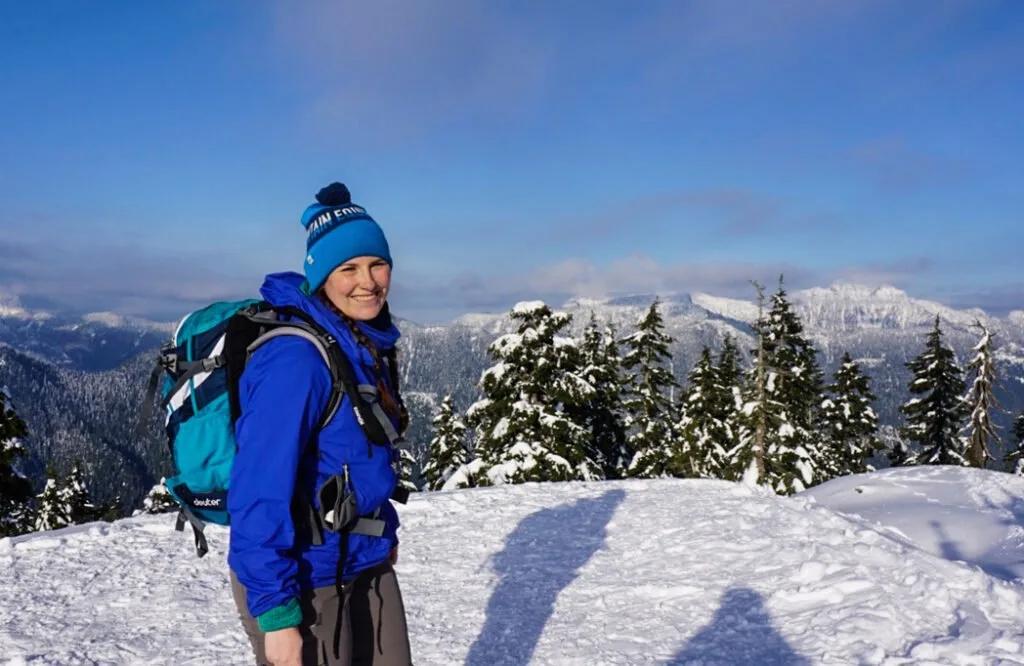
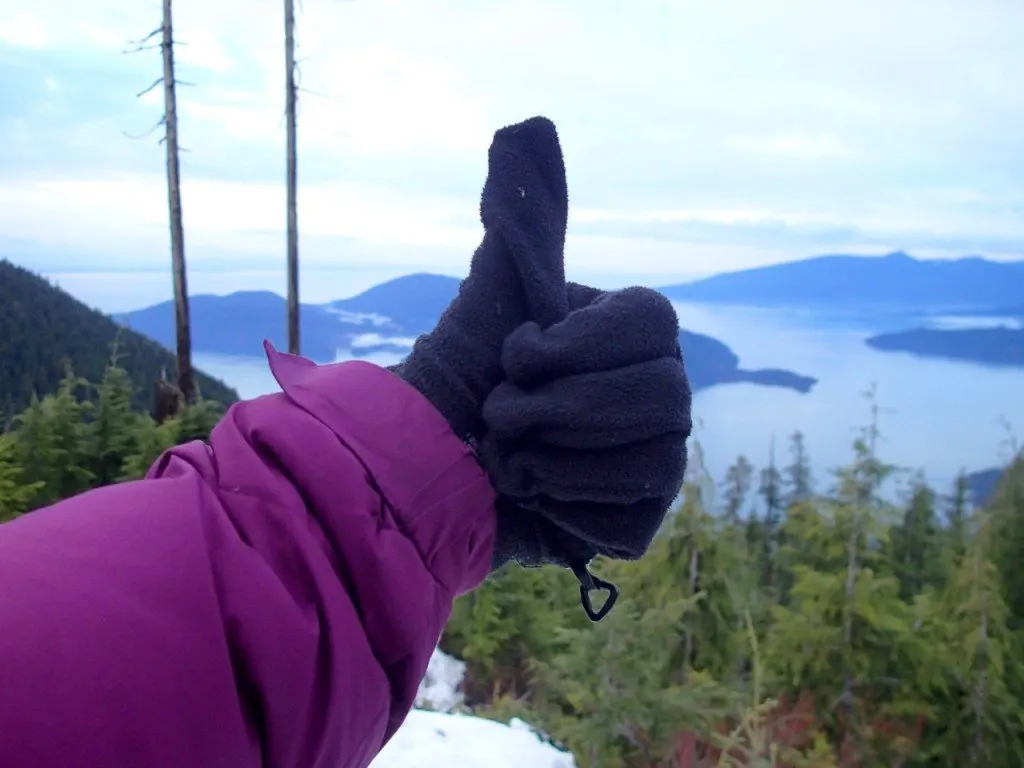
Tonie
Wednesday 4th of November 2015
Thank you so much this is fantastic! Very useful feedback and the details are fantastic - especially for someone who is less knowledgeable with brands and types of gears there are! Shopping can be overwhelming at times so it is good to know what to look for specifically.
Keep it up Taryn!